University: NSB303 Assessment 1 - Ruby Pascal Case Study Analysis
VerifiedAdded on 2022/09/09
|7
|1731
|17
Report
AI Summary
This report analyzes the case of Mrs. Ruby Pascal, a 43-year-old patient admitted to the emergency department with severe anxiety attacks, and a history of general anxiety disorder, and type 2 diabetes. The assessment focuses on developing a health promotion plan using the Clinical Reasoning Cycle (CRC) template. The plan identifies three key problems: social anxiety disorder, PTSD, and panic disorder, and proposes Cognitive Behavioral Therapy (CBT) as the primary intervention. The report discusses the effectiveness of CBT, including its components like psychoeducation, cognitive recovery, and homework assignments, alongside behavioral approaches, and the use of pharmacotherapy and physical treatments such as exercise and yoga. Motivational interviewing is also discussed as a key psychotherapeutic strategy. The assessment emphasizes collaboration and autonomy, reflecting the nurse's role in empowering the patient. The report also references several studies supporting the efficacy of CBT and other interventions for managing anxiety and related disorders. The goal of the health promotion plan is to help Mrs. Pascal improve her mental and physical well-being.

Running head:NSB303
NSB303
Name of the student
Name of the university
Author note
NSB303
Name of the student
Name of the university
Author note
Paraphrase This Document
Need a fresh take? Get an instant paraphrase of this document with our AI Paraphraser
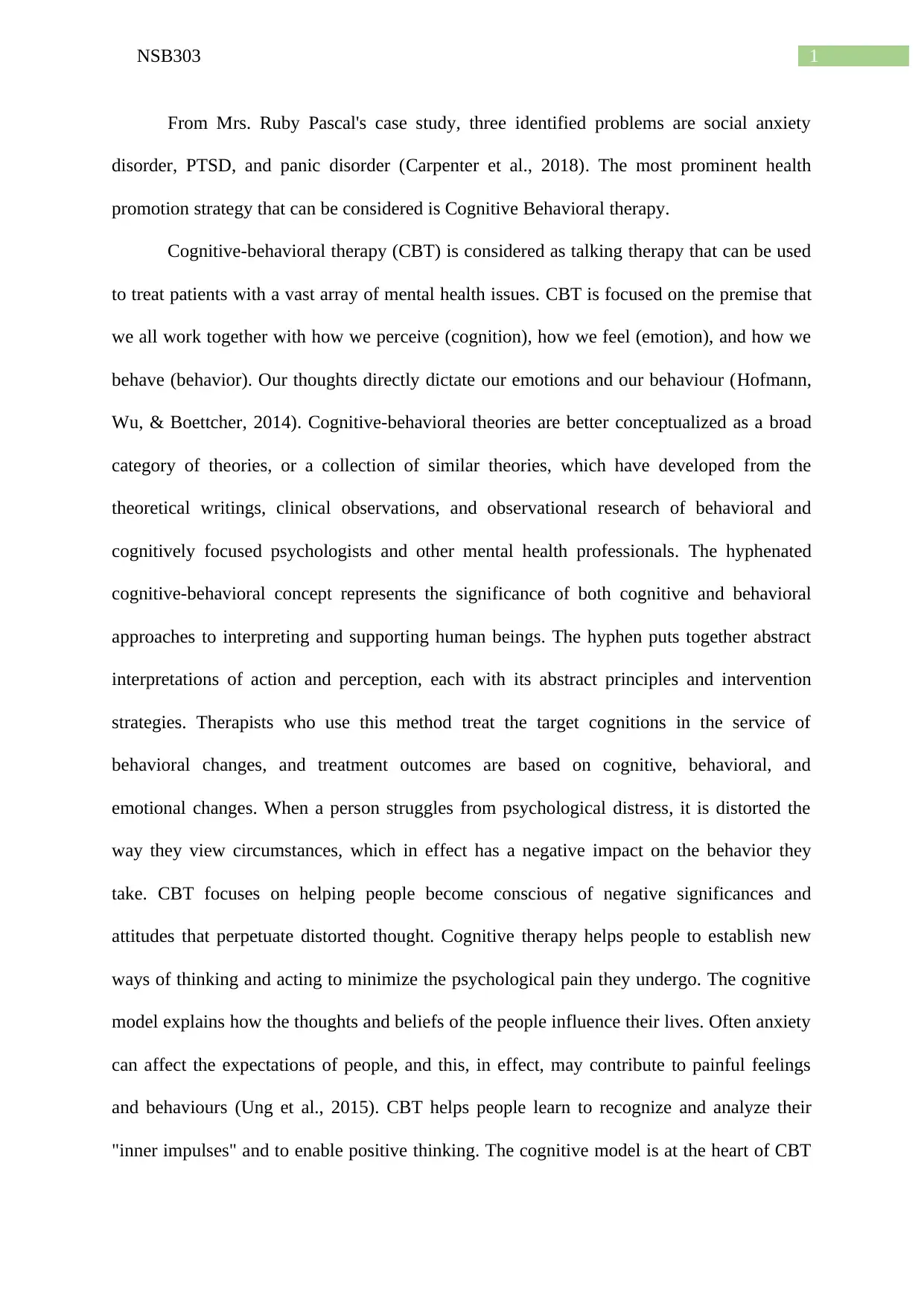
1NSB303
From Mrs. Ruby Pascal's case study, three identified problems are social anxiety
disorder, PTSD, and panic disorder (Carpenter et al., 2018). The most prominent health
promotion strategy that can be considered is Cognitive Behavioral therapy.
Cognitive-behavioral therapy (CBT) is considered as talking therapy that can be used
to treat patients with a vast array of mental health issues. CBT is focused on the premise that
we all work together with how we perceive (cognition), how we feel (emotion), and how we
behave (behavior). Our thoughts directly dictate our emotions and our behaviour (Hofmann,
Wu, & Boettcher, 2014). Cognitive-behavioral theories are better conceptualized as a broad
category of theories, or a collection of similar theories, which have developed from the
theoretical writings, clinical observations, and observational research of behavioral and
cognitively focused psychologists and other mental health professionals. The hyphenated
cognitive-behavioral concept represents the significance of both cognitive and behavioral
approaches to interpreting and supporting human beings. The hyphen puts together abstract
interpretations of action and perception, each with its abstract principles and intervention
strategies. Therapists who use this method treat the target cognitions in the service of
behavioral changes, and treatment outcomes are based on cognitive, behavioral, and
emotional changes. When a person struggles from psychological distress, it is distorted the
way they view circumstances, which in effect has a negative impact on the behavior they
take. CBT focuses on helping people become conscious of negative significances and
attitudes that perpetuate distorted thought. Cognitive therapy helps people to establish new
ways of thinking and acting to minimize the psychological pain they undergo. The cognitive
model explains how the thoughts and beliefs of the people influence their lives. Often anxiety
can affect the expectations of people, and this, in effect, may contribute to painful feelings
and behaviours (Ung et al., 2015). CBT helps people learn to recognize and analyze their
"inner impulses" and to enable positive thinking. The cognitive model is at the heart of CBT
From Mrs. Ruby Pascal's case study, three identified problems are social anxiety
disorder, PTSD, and panic disorder (Carpenter et al., 2018). The most prominent health
promotion strategy that can be considered is Cognitive Behavioral therapy.
Cognitive-behavioral therapy (CBT) is considered as talking therapy that can be used
to treat patients with a vast array of mental health issues. CBT is focused on the premise that
we all work together with how we perceive (cognition), how we feel (emotion), and how we
behave (behavior). Our thoughts directly dictate our emotions and our behaviour (Hofmann,
Wu, & Boettcher, 2014). Cognitive-behavioral theories are better conceptualized as a broad
category of theories, or a collection of similar theories, which have developed from the
theoretical writings, clinical observations, and observational research of behavioral and
cognitively focused psychologists and other mental health professionals. The hyphenated
cognitive-behavioral concept represents the significance of both cognitive and behavioral
approaches to interpreting and supporting human beings. The hyphen puts together abstract
interpretations of action and perception, each with its abstract principles and intervention
strategies. Therapists who use this method treat the target cognitions in the service of
behavioral changes, and treatment outcomes are based on cognitive, behavioral, and
emotional changes. When a person struggles from psychological distress, it is distorted the
way they view circumstances, which in effect has a negative impact on the behavior they
take. CBT focuses on helping people become conscious of negative significances and
attitudes that perpetuate distorted thought. Cognitive therapy helps people to establish new
ways of thinking and acting to minimize the psychological pain they undergo. The cognitive
model explains how the thoughts and beliefs of the people influence their lives. Often anxiety
can affect the expectations of people, and this, in effect, may contribute to painful feelings
and behaviours (Ung et al., 2015). CBT helps people learn to recognize and analyze their
"inner impulses" and to enable positive thinking. The cognitive model is at the heart of CBT
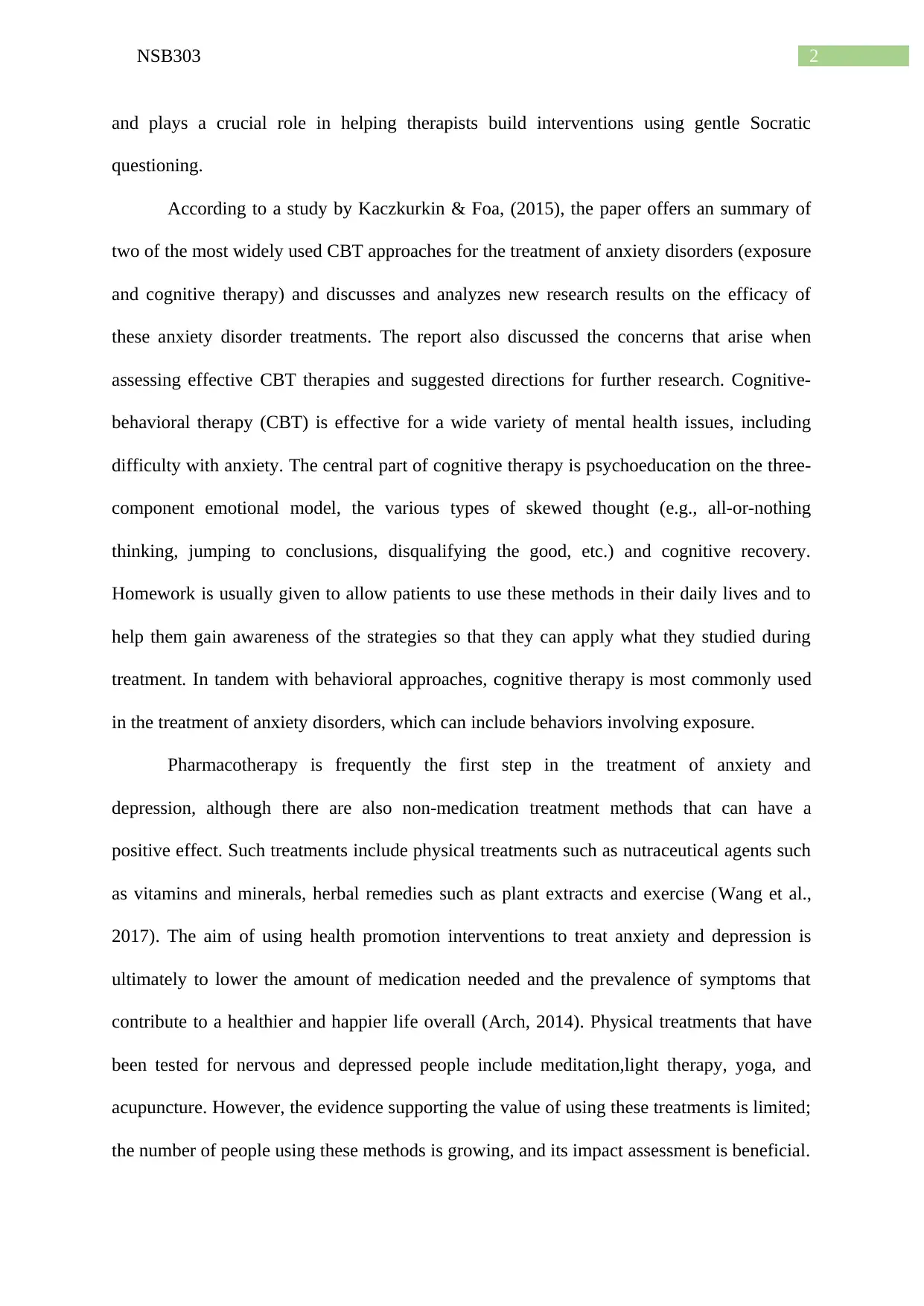
2NSB303
and plays a crucial role in helping therapists build interventions using gentle Socratic
questioning.
According to a study by Kaczkurkin & Foa, (2015), the paper offers an summary of
two of the most widely used CBT approaches for the treatment of anxiety disorders (exposure
and cognitive therapy) and discusses and analyzes new research results on the efficacy of
these anxiety disorder treatments. The report also discussed the concerns that arise when
assessing effective CBT therapies and suggested directions for further research. Cognitive-
behavioral therapy (CBT) is effective for a wide variety of mental health issues, including
difficulty with anxiety. The central part of cognitive therapy is psychoeducation on the three-
component emotional model, the various types of skewed thought (e.g., all-or-nothing
thinking, jumping to conclusions, disqualifying the good, etc.) and cognitive recovery.
Homework is usually given to allow patients to use these methods in their daily lives and to
help them gain awareness of the strategies so that they can apply what they studied during
treatment. In tandem with behavioral approaches, cognitive therapy is most commonly used
in the treatment of anxiety disorders, which can include behaviors involving exposure.
Pharmacotherapy is frequently the first step in the treatment of anxiety and
depression, although there are also non-medication treatment methods that can have a
positive effect. Such treatments include physical treatments such as nutraceutical agents such
as vitamins and minerals, herbal remedies such as plant extracts and exercise (Wang et al.,
2017). The aim of using health promotion interventions to treat anxiety and depression is
ultimately to lower the amount of medication needed and the prevalence of symptoms that
contribute to a healthier and happier life overall (Arch, 2014). Physical treatments that have
been tested for nervous and depressed people include meditation,light therapy, yoga, and
acupuncture. However, the evidence supporting the value of using these treatments is limited;
the number of people using these methods is growing, and its impact assessment is beneficial.
and plays a crucial role in helping therapists build interventions using gentle Socratic
questioning.
According to a study by Kaczkurkin & Foa, (2015), the paper offers an summary of
two of the most widely used CBT approaches for the treatment of anxiety disorders (exposure
and cognitive therapy) and discusses and analyzes new research results on the efficacy of
these anxiety disorder treatments. The report also discussed the concerns that arise when
assessing effective CBT therapies and suggested directions for further research. Cognitive-
behavioral therapy (CBT) is effective for a wide variety of mental health issues, including
difficulty with anxiety. The central part of cognitive therapy is psychoeducation on the three-
component emotional model, the various types of skewed thought (e.g., all-or-nothing
thinking, jumping to conclusions, disqualifying the good, etc.) and cognitive recovery.
Homework is usually given to allow patients to use these methods in their daily lives and to
help them gain awareness of the strategies so that they can apply what they studied during
treatment. In tandem with behavioral approaches, cognitive therapy is most commonly used
in the treatment of anxiety disorders, which can include behaviors involving exposure.
Pharmacotherapy is frequently the first step in the treatment of anxiety and
depression, although there are also non-medication treatment methods that can have a
positive effect. Such treatments include physical treatments such as nutraceutical agents such
as vitamins and minerals, herbal remedies such as plant extracts and exercise (Wang et al.,
2017). The aim of using health promotion interventions to treat anxiety and depression is
ultimately to lower the amount of medication needed and the prevalence of symptoms that
contribute to a healthier and happier life overall (Arch, 2014). Physical treatments that have
been tested for nervous and depressed people include meditation,light therapy, yoga, and
acupuncture. However, the evidence supporting the value of using these treatments is limited;
the number of people using these methods is growing, and its impact assessment is beneficial.
⊘ This is a preview!⊘
Do you want full access?
Subscribe today to unlock all pages.

Trusted by 1+ million students worldwide
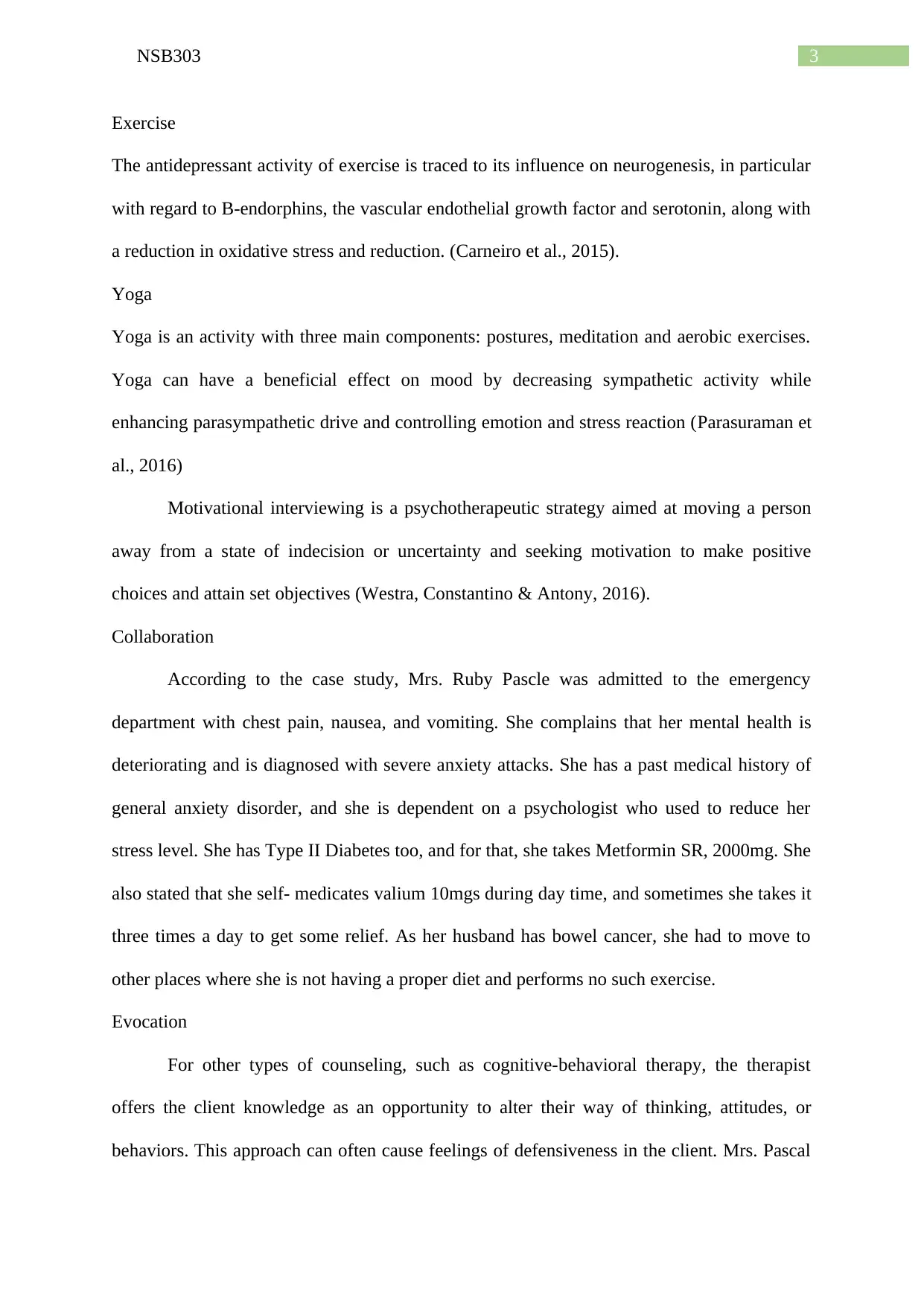
3NSB303
Exercise
The antidepressant activity of exercise is traced to its influence on neurogenesis, in particular
with regard to B-endorphins, the vascular endothelial growth factor and serotonin, along with
a reduction in oxidative stress and reduction. (Carneiro et al., 2015).
Yoga
Yoga is an activity with three main components: postures, meditation and aerobic exercises.
Yoga can have a beneficial effect on mood by decreasing sympathetic activity while
enhancing parasympathetic drive and controlling emotion and stress reaction (Parasuraman et
al., 2016)
Motivational interviewing is a psychotherapeutic strategy aimed at moving a person
away from a state of indecision or uncertainty and seeking motivation to make positive
choices and attain set objectives (Westra, Constantino & Antony, 2016).
Collaboration
According to the case study, Mrs. Ruby Pascle was admitted to the emergency
department with chest pain, nausea, and vomiting. She complains that her mental health is
deteriorating and is diagnosed with severe anxiety attacks. She has a past medical history of
general anxiety disorder, and she is dependent on a psychologist who used to reduce her
stress level. She has Type II Diabetes too, and for that, she takes Metformin SR, 2000mg. She
also stated that she self- medicates valium 10mgs during day time, and sometimes she takes it
three times a day to get some relief. As her husband has bowel cancer, she had to move to
other places where she is not having a proper diet and performs no such exercise.
Evocation
For other types of counseling, such as cognitive-behavioral therapy, the therapist
offers the client knowledge as an opportunity to alter their way of thinking, attitudes, or
behaviors. This approach can often cause feelings of defensiveness in the client. Mrs. Pascal
Exercise
The antidepressant activity of exercise is traced to its influence on neurogenesis, in particular
with regard to B-endorphins, the vascular endothelial growth factor and serotonin, along with
a reduction in oxidative stress and reduction. (Carneiro et al., 2015).
Yoga
Yoga is an activity with three main components: postures, meditation and aerobic exercises.
Yoga can have a beneficial effect on mood by decreasing sympathetic activity while
enhancing parasympathetic drive and controlling emotion and stress reaction (Parasuraman et
al., 2016)
Motivational interviewing is a psychotherapeutic strategy aimed at moving a person
away from a state of indecision or uncertainty and seeking motivation to make positive
choices and attain set objectives (Westra, Constantino & Antony, 2016).
Collaboration
According to the case study, Mrs. Ruby Pascle was admitted to the emergency
department with chest pain, nausea, and vomiting. She complains that her mental health is
deteriorating and is diagnosed with severe anxiety attacks. She has a past medical history of
general anxiety disorder, and she is dependent on a psychologist who used to reduce her
stress level. She has Type II Diabetes too, and for that, she takes Metformin SR, 2000mg. She
also stated that she self- medicates valium 10mgs during day time, and sometimes she takes it
three times a day to get some relief. As her husband has bowel cancer, she had to move to
other places where she is not having a proper diet and performs no such exercise.
Evocation
For other types of counseling, such as cognitive-behavioral therapy, the therapist
offers the client knowledge as an opportunity to alter their way of thinking, attitudes, or
behaviors. This approach can often cause feelings of defensiveness in the client. Mrs. Pascal
Paraphrase This Document
Need a fresh take? Get an instant paraphrase of this document with our AI Paraphraser
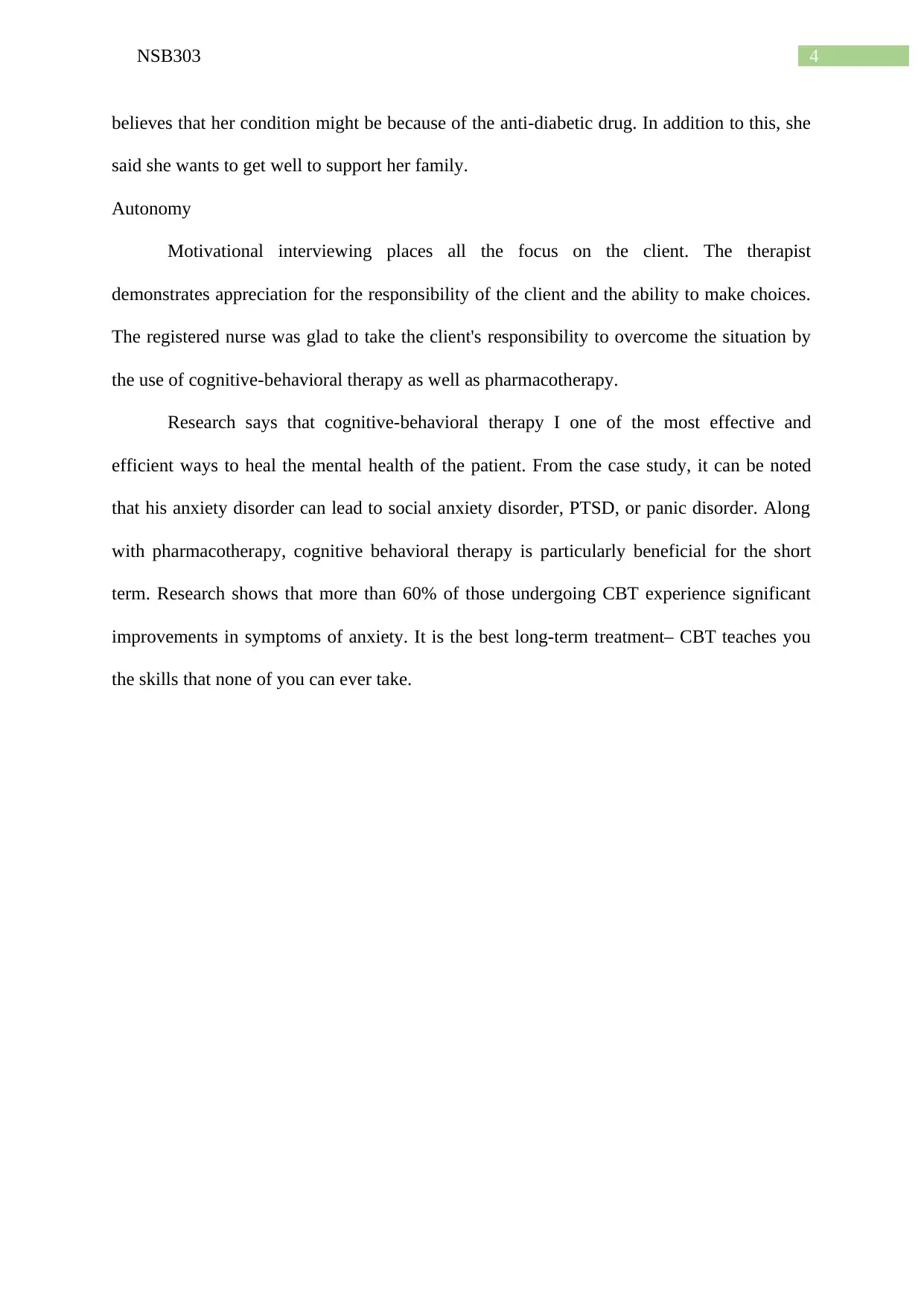
4NSB303
believes that her condition might be because of the anti-diabetic drug. In addition to this, she
said she wants to get well to support her family.
Autonomy
Motivational interviewing places all the focus on the client. The therapist
demonstrates appreciation for the responsibility of the client and the ability to make choices.
The registered nurse was glad to take the client's responsibility to overcome the situation by
the use of cognitive-behavioral therapy as well as pharmacotherapy.
Research says that cognitive-behavioral therapy I one of the most effective and
efficient ways to heal the mental health of the patient. From the case study, it can be noted
that his anxiety disorder can lead to social anxiety disorder, PTSD, or panic disorder. Along
with pharmacotherapy, cognitive behavioral therapy is particularly beneficial for the short
term. Research shows that more than 60% of those undergoing CBT experience significant
improvements in symptoms of anxiety. It is the best long-term treatment– CBT teaches you
the skills that none of you can ever take.
believes that her condition might be because of the anti-diabetic drug. In addition to this, she
said she wants to get well to support her family.
Autonomy
Motivational interviewing places all the focus on the client. The therapist
demonstrates appreciation for the responsibility of the client and the ability to make choices.
The registered nurse was glad to take the client's responsibility to overcome the situation by
the use of cognitive-behavioral therapy as well as pharmacotherapy.
Research says that cognitive-behavioral therapy I one of the most effective and
efficient ways to heal the mental health of the patient. From the case study, it can be noted
that his anxiety disorder can lead to social anxiety disorder, PTSD, or panic disorder. Along
with pharmacotherapy, cognitive behavioral therapy is particularly beneficial for the short
term. Research shows that more than 60% of those undergoing CBT experience significant
improvements in symptoms of anxiety. It is the best long-term treatment– CBT teaches you
the skills that none of you can ever take.

5NSB303
References
Arch, J. J. (2014). Cognitive behavioral therapy and pharmacotherapy for anxiety: Treatment
preferences and credibility among pregnant and non-pregnant women. Behaviour
research and therapy, 52, 53-60.
Carneiro, L. S., Fonseca, A. M., Vieira-Coelho, M. A., Mota, M. P., & Vasconcelos-Raposo,
J. (2015). Effects of structured exercise and pharmacotherapy vs. pharmacotherapy
for adults with depressive symptoms: a randomized clinical trial. Journal of
psychiatric research, 71, 48-55.
Carpenter, J. K., Andrews, L. A., Witcraft, S. M., Powers, M. B., Smits, J. A., & Hofmann, S.
G. (2018). Cognitive behavioral therapy for anxiety and related disorders: A meta‐
analysis of randomized placebo‐controlled trials. Depression and anxiety, 35(6), 502-
514.
Hofmann, S. G., Wu, J. Q., & Boettcher, H. (2014). Effect of cognitive-behavioral therapy
for anxiety disorders on quality of life: a meta-analysis. Journal of consulting and
clinical psychology, 82(3), 375.
Kaczkurkin, A. N., & Foa, E. B. (2015). Cognitive-behavioral therapy for anxiety disorders:
an update on the empirical evidence. Dialogues in clinical neuroscience, 17(3), 337.
Parasuraman, S., Wen, L. E., Zhen, K. M., Hean, C. K., & Sam, A. T. (2016). Exploring the
pharmacological and pharmacotherapeutic effects of yoga. Pharmacology, Toxicology
and Biomedical Reports, 2(1).
Ung, D., Selles, R., Small, B. J., & Storch, E. A. (2015). A systematic review and meta-
analysis of cognitive-behavioral therapy for anxiety in youth with high-functioning
autism spectrum disorders. Child Psychiatry & Human Development, 46(4), 533-547.
Wang, Z., Whiteside, S. P., Sim, L., Farah, W., Morrow, A. S., Alsawas, M., ... & Daraz, L.
(2017). Comparative effectiveness and safety of cognitive behavioral therapy and
References
Arch, J. J. (2014). Cognitive behavioral therapy and pharmacotherapy for anxiety: Treatment
preferences and credibility among pregnant and non-pregnant women. Behaviour
research and therapy, 52, 53-60.
Carneiro, L. S., Fonseca, A. M., Vieira-Coelho, M. A., Mota, M. P., & Vasconcelos-Raposo,
J. (2015). Effects of structured exercise and pharmacotherapy vs. pharmacotherapy
for adults with depressive symptoms: a randomized clinical trial. Journal of
psychiatric research, 71, 48-55.
Carpenter, J. K., Andrews, L. A., Witcraft, S. M., Powers, M. B., Smits, J. A., & Hofmann, S.
G. (2018). Cognitive behavioral therapy for anxiety and related disorders: A meta‐
analysis of randomized placebo‐controlled trials. Depression and anxiety, 35(6), 502-
514.
Hofmann, S. G., Wu, J. Q., & Boettcher, H. (2014). Effect of cognitive-behavioral therapy
for anxiety disorders on quality of life: a meta-analysis. Journal of consulting and
clinical psychology, 82(3), 375.
Kaczkurkin, A. N., & Foa, E. B. (2015). Cognitive-behavioral therapy for anxiety disorders:
an update on the empirical evidence. Dialogues in clinical neuroscience, 17(3), 337.
Parasuraman, S., Wen, L. E., Zhen, K. M., Hean, C. K., & Sam, A. T. (2016). Exploring the
pharmacological and pharmacotherapeutic effects of yoga. Pharmacology, Toxicology
and Biomedical Reports, 2(1).
Ung, D., Selles, R., Small, B. J., & Storch, E. A. (2015). A systematic review and meta-
analysis of cognitive-behavioral therapy for anxiety in youth with high-functioning
autism spectrum disorders. Child Psychiatry & Human Development, 46(4), 533-547.
Wang, Z., Whiteside, S. P., Sim, L., Farah, W., Morrow, A. S., Alsawas, M., ... & Daraz, L.
(2017). Comparative effectiveness and safety of cognitive behavioral therapy and
⊘ This is a preview!⊘
Do you want full access?
Subscribe today to unlock all pages.

Trusted by 1+ million students worldwide
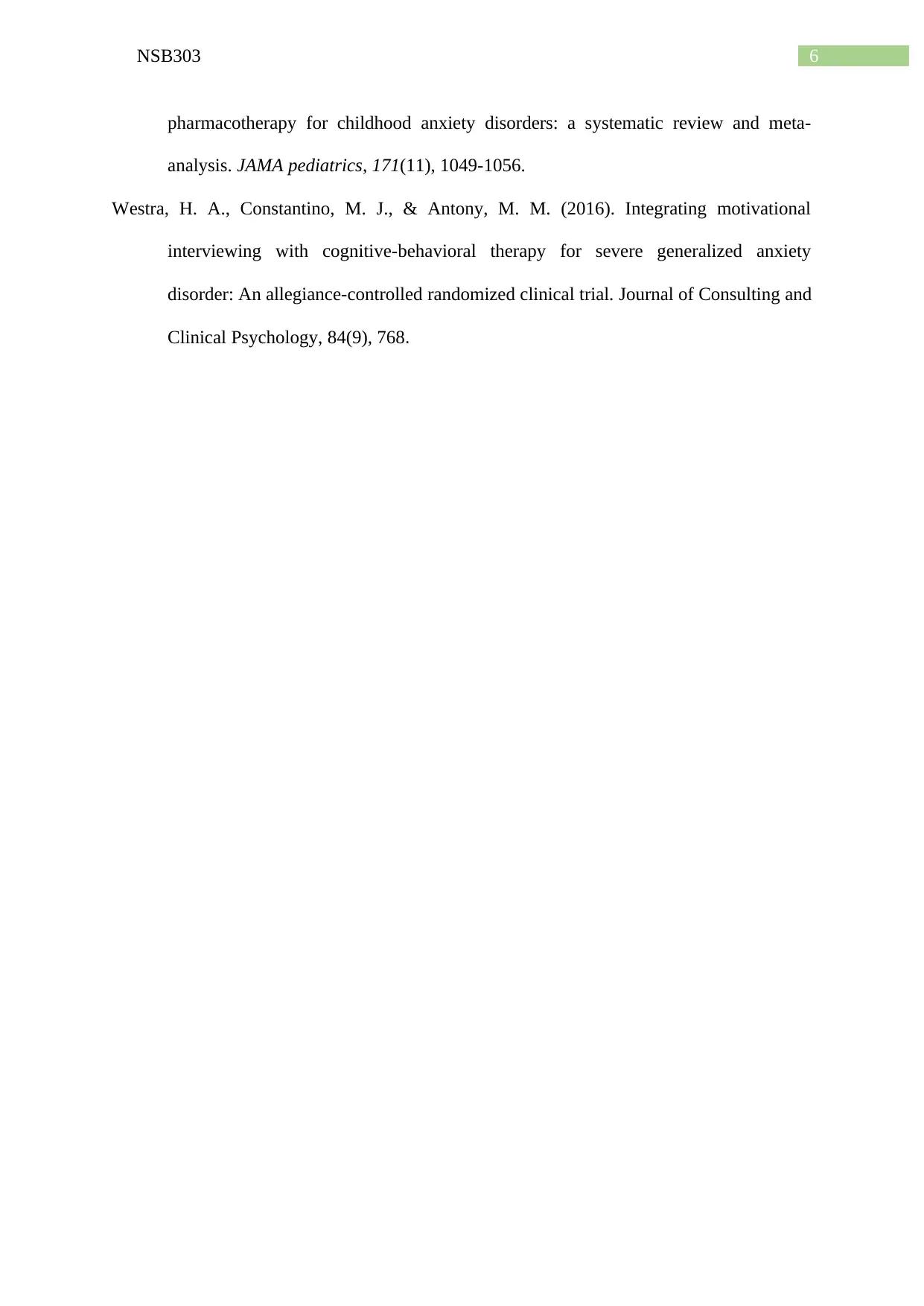
6NSB303
pharmacotherapy for childhood anxiety disorders: a systematic review and meta-
analysis. JAMA pediatrics, 171(11), 1049-1056.
Westra, H. A., Constantino, M. J., & Antony, M. M. (2016). Integrating motivational
interviewing with cognitive-behavioral therapy for severe generalized anxiety
disorder: An allegiance-controlled randomized clinical trial. Journal of Consulting and
Clinical Psychology, 84(9), 768.
pharmacotherapy for childhood anxiety disorders: a systematic review and meta-
analysis. JAMA pediatrics, 171(11), 1049-1056.
Westra, H. A., Constantino, M. J., & Antony, M. M. (2016). Integrating motivational
interviewing with cognitive-behavioral therapy for severe generalized anxiety
disorder: An allegiance-controlled randomized clinical trial. Journal of Consulting and
Clinical Psychology, 84(9), 768.
1 out of 7
Related Documents
Your All-in-One AI-Powered Toolkit for Academic Success.
+13062052269
info@desklib.com
Available 24*7 on WhatsApp / Email
![[object Object]](/_next/static/media/star-bottom.7253800d.svg)
Unlock your academic potential
Copyright © 2020–2025 A2Z Services. All Rights Reserved. Developed and managed by ZUCOL.




